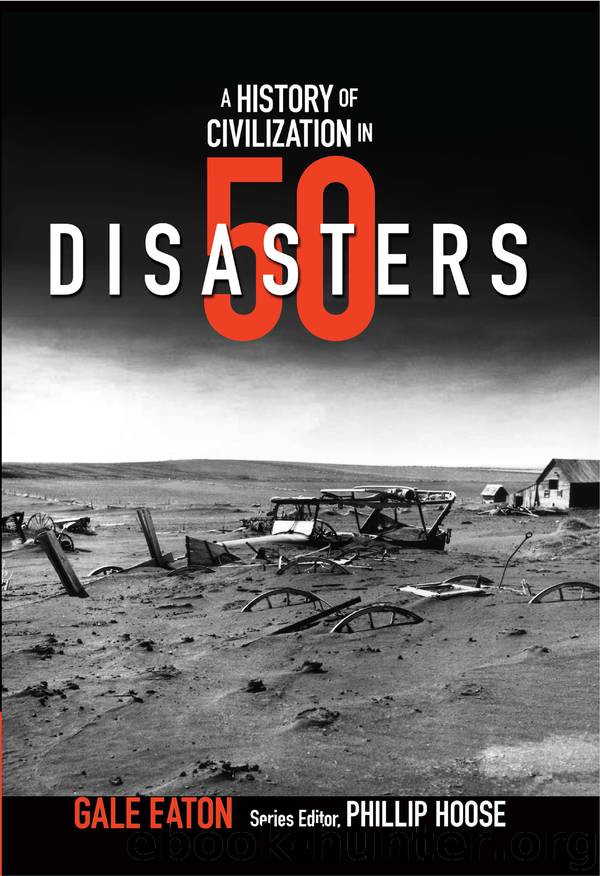A History of Civilization in 50 Disasters by Gale Eaton

Author:Gale Eaton
Language: eng
Format: epub
Publisher: Tilbury House Publishers
Smog over Southeast Asia remains a problem. This 2013 photograph shows Singapore haze.. (Brian Jeffery Beggerly)
How did it happen? Climate was a factor, with the worst El Niño/Southern Oscillation (ENSO) drought in years. Terrain contributed, too. Much of Indonesia’s peat-swamp forest grew over sandy, fast-draining soil; when drought caused the water level to drop, the dry forest burned easily. So did the peat itself.5 And peat, given enough time, can turn into coal. Deep under the soil, fires smoldered in coal seams until the next dry season. This much was natural.
But humans set fires on purpose to clear land for cultivation. Small farmers had been doing this for centuries. Now Indonesia had huge commercial farms. Trees provided many of its major exports, including plywood,6 tropical hardwood,7 pulp and paper, and palm oil.8 Loggers cleared more land, and their practices made it easier for fires to spread.9 From 1982 on, wildfires increased. In 1995, Indonesia banned the use of fire for clearing land, but fires were set illegally. To put them out, the government needed more and better equipment, maps, personnel, access to water, and even roads.
Why was it a disaster? The haze reportedly killed 527 Indonesians between September and November. Another 16,000 were hospitalized, and 36,000 received outpatient care. Others died in collisions on land, sea, and in the air.10 Malaysia and Singapore advised their citizens to avoid outdoor exercise and filter the air, but of course many had to work outside and could not afford air conditioning. Breathing the air in the worst-affected areas was as bad as smoking up to 80 cigarettes a day.11
The region’s economy lost over $9 billion. Its ecology may have suffered more. Indonesia had some of the planet’s most diverse wildlife and its third largest rain forest. The fires killed many plants and animals directly and destroyed the habitats of others. What survived was dry and brittle—more vulnerable to future fires. The government estimated that fire on Kalimantan consumed 520,000 hectares (over 2,000 square miles, about the area of Delaware) in 1997–98; satellite images showed ten times as much damage.12
The haze strained relationships between Indonesia and her neighbors. The Association of Southeast Asian Nations (ASEAN) adopted a Cooperative Plan on Transboundary Pollution in 1995, but it was hard to enforce.13 Governments, NGOs (non-governmental organizations—i.e., non-profit citizens’ groups), and private corporations struggled with the problem. In 2013, El Niño came back, and so did the haze.14 Indonesia, with the world’s fourth largest population, now has the third largest greenhouse gas emissions—and 75% of them come from deforestation and damage to forest and peatlands.15 Environmentalists have boycotted some large companies until they agreed to zero-deforestation policies and more sustainable development.16
Download
This site does not store any files on its server. We only index and link to content provided by other sites. Please contact the content providers to delete copyright contents if any and email us, we'll remove relevant links or contents immediately.
| Anthropology | Archaeology |
| Philosophy | Politics & Government |
| Social Sciences | Sociology |
| Women's Studies |
Cecilia; Or, Memoirs of an Heiress — Volume 1 by Fanny Burney(32062)
Cecilia; Or, Memoirs of an Heiress — Volume 3 by Fanny Burney(31458)
Cecilia; Or, Memoirs of an Heiress — Volume 2 by Fanny Burney(31409)
The Great Music City by Andrea Baker(30781)
We're Going to Need More Wine by Gabrielle Union(18633)
All the Missing Girls by Megan Miranda(14737)
Pimp by Iceberg Slim(13779)
Bombshells: Glamour Girls of a Lifetime by Sullivan Steve(13685)
Fifty Shades Freed by E L James(12916)
Talking to Strangers by Malcolm Gladwell(12875)
Norse Mythology by Gaiman Neil(12828)
For the Love of Europe by Rick Steves(11477)
Crazy Rich Asians by Kevin Kwan(8888)
Mindhunter: Inside the FBI's Elite Serial Crime Unit by John E. Douglas & Mark Olshaker(8702)
The Lost Art of Listening by Michael P. Nichols(7160)
Enlightenment Now: The Case for Reason, Science, Humanism, and Progress by Steven Pinker(6875)
The Four Agreements by Don Miguel Ruiz(6319)
Bad Blood by John Carreyrou(6278)
Weapons of Math Destruction by Cathy O'Neil(5832)
